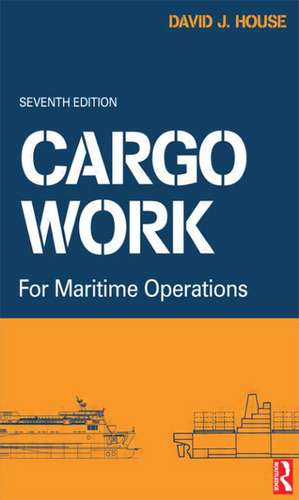Cargo Work
Autor David J Houseen Limba Engleză Paperback – 31 mar 2005
The book covers general principles and the latest international regulations that affect all cargo work, including cargo types and key characteristics of a wide range of cargo classes. It also details Roll On - Roll Off cargo handling, containerisation, equipment and offshore supply.
Preț: 345.48 lei
Nou
Puncte Express: 518
Preț estimativ în valută:
66.12€ • 71.79$ • 55.54£
66.12€ • 71.79$ • 55.54£
Carte tipărită la comandă
Livrare economică 16-30 aprilie
Preluare comenzi: 021 569.72.76
Specificații
ISBN-13: 9780750665551
ISBN-10: 0750665556
Pagini: 344
Ilustrații: black & white illustrations
Dimensiuni: 153 x 228 x 20 mm
Greutate: 0.52 kg
Ediția:Revizuită
Editura: Taylor & Francis
ISBN-10: 0750665556
Pagini: 344
Ilustrații: black & white illustrations
Dimensiuni: 153 x 228 x 20 mm
Greutate: 0.52 kg
Ediția:Revizuită
Editura: Taylor & Francis
Public țintă
Nautical college students from Cadet to Officer of the Watch & Master level, and those studying for professional marine qualifications under the International Maritime Organisation STCW requirements (Standards of Training and Watchkeeping) licensing courses; Serving Merchant Navy Deck Officers; Officer of the Watch; Chief Mates; Shipping agents, transport managers, harbour and port authoritiesCuprins
Chapter 1. ߝ Introduction to handling and stowage of cargoes, Cargo gear definitions, Derrick rigs: Union, Speed cranes, Hallen, Velle, Lifting gear,
Testing of plant maintenance of lifting gear, Deck cranes, Heavy duty cranes, Advantages and dis-advantages derricks/cranes, Gantry cranes, Slinging arrangements, Pallatisation, Fork lift truck use
Chapter 2.- Introduction to hatch work and heavy lift, Hatchwork definitions, Conventional design and hold structure, Hatchtop types and operations, Cargo decks, Heavy lift operations, Heavy duty derricks and cranes, Tandem loading, Stuelcken system, Floating cranes and sheer legs, Heavy lift ships, Project cargoes and heavy lift transports
Chapter 3 ߝ Introduction on cargo properties, Preparation of cargo spaces, Duties of the cargo officer, Stowage plans, Steel cargoes, Bagged cargoes, Bale goods, General cargoes, Cargo monitoring, Sweat and ventilation, Hatch features, Use of deep tanks, Side loading methods. Ballast management, stability and loadlines
Chapter 4 - Introduction to bulk cargoes, Definitions and terminology for bulk products, Bulk carrier construction and design, Hold preparation, Grain cargoes, Procedures for loading, shifting boards, Coal, characteristics, categories and procedures, precautions, Iron and steel cargoes, Bulk examples, hazards and procedures, Stress monitors
Chapter 5 ߝ Introduction to tankers, Definitions and tanker terminology, Tanker design and requirements and construction, Pipeline systems, Measurement of liquid cargoes, Loading procedures, Cargoes in transit and being discharged, Ballasting and tank cleaning, Crude oil washing, Inert gas systems and operational requirements, Gas detection, Explosi-meters and oxygen analysers, Tanker cargoes, Chemical carriers, Chemical terminology, Design features, Operational features with bulk chemicals, Bulk liquefied gas carriage, Gas carrier profile, Operational features carrying gas, Deepwell cargo pumps
Chapter 6- Introduction to specialist cargoes, Timber cargo, Types, Operational aspects, Refrigerated cargoes and the reefer vessel, Hold insulation, Refrigeration plant, Qualities of refrigerants, Frozen and chilled cargoes : meats, dairy products, fish, and fruit. Carriage of livestock
Chapter 7- Introduction to Roll On - Roll Off operations, Ferries and pertinent features, Profile of the Ro-Ro, Access to vehicle decks, Bow visors, Stern ramps, Cargo doors, Vehicle decks, Ventilation and drainage systems, Cargo types, Vehicle specifics, Stowage and securing of cargoes, Ship stabilty and monitoring precautions, Linkspans, High speed craft, Car carriers, Unit load systems
Chapter 8- Introduction to containers and containerisation, Terms and terminology of containers, Container markings, Container transports and their construction, Stowage plans, Container types and stowage, Lashings and securings for units, Methods of securing deck stacks, Container operations and documentation, Reefer units, Loadicator and plans, Terminal operations, Shipping procedures
Chapter 9- Introduction to hazardous goods and deck cargoes, Terminology of hazardous cargoes and deck cargoes, The IMDG code use and reference, Classes of documentation for hazardous goods, Package requirements, Recommendations on deck cargoes, Hazards of specific cargoes
Chapter 10- Introduction to stability, security and cargo documentation, The ISPS code and its implications, Definitions affecting ships and cargo security, Security operations and progress, Summary of cargo documentation, Stability calculation examples
Testing of plant maintenance of lifting gear, Deck cranes, Heavy duty cranes, Advantages and dis-advantages derricks/cranes, Gantry cranes, Slinging arrangements, Pallatisation, Fork lift truck use
Chapter 2.- Introduction to hatch work and heavy lift, Hatchwork definitions, Conventional design and hold structure, Hatchtop types and operations, Cargo decks, Heavy lift operations, Heavy duty derricks and cranes, Tandem loading, Stuelcken system, Floating cranes and sheer legs, Heavy lift ships, Project cargoes and heavy lift transports
Chapter 3 ߝ Introduction on cargo properties, Preparation of cargo spaces, Duties of the cargo officer, Stowage plans, Steel cargoes, Bagged cargoes, Bale goods, General cargoes, Cargo monitoring, Sweat and ventilation, Hatch features, Use of deep tanks, Side loading methods. Ballast management, stability and loadlines
Chapter 4 - Introduction to bulk cargoes, Definitions and terminology for bulk products, Bulk carrier construction and design, Hold preparation, Grain cargoes, Procedures for loading, shifting boards, Coal, characteristics, categories and procedures, precautions, Iron and steel cargoes, Bulk examples, hazards and procedures, Stress monitors
Chapter 5 ߝ Introduction to tankers, Definitions and tanker terminology, Tanker design and requirements and construction, Pipeline systems, Measurement of liquid cargoes, Loading procedures, Cargoes in transit and being discharged, Ballasting and tank cleaning, Crude oil washing, Inert gas systems and operational requirements, Gas detection, Explosi-meters and oxygen analysers, Tanker cargoes, Chemical carriers, Chemical terminology, Design features, Operational features with bulk chemicals, Bulk liquefied gas carriage, Gas carrier profile, Operational features carrying gas, Deepwell cargo pumps
Chapter 6- Introduction to specialist cargoes, Timber cargo, Types, Operational aspects, Refrigerated cargoes and the reefer vessel, Hold insulation, Refrigeration plant, Qualities of refrigerants, Frozen and chilled cargoes : meats, dairy products, fish, and fruit. Carriage of livestock
Chapter 7- Introduction to Roll On - Roll Off operations, Ferries and pertinent features, Profile of the Ro-Ro, Access to vehicle decks, Bow visors, Stern ramps, Cargo doors, Vehicle decks, Ventilation and drainage systems, Cargo types, Vehicle specifics, Stowage and securing of cargoes, Ship stabilty and monitoring precautions, Linkspans, High speed craft, Car carriers, Unit load systems
Chapter 8- Introduction to containers and containerisation, Terms and terminology of containers, Container markings, Container transports and their construction, Stowage plans, Container types and stowage, Lashings and securings for units, Methods of securing deck stacks, Container operations and documentation, Reefer units, Loadicator and plans, Terminal operations, Shipping procedures
Chapter 9- Introduction to hazardous goods and deck cargoes, Terminology of hazardous cargoes and deck cargoes, The IMDG code use and reference, Classes of documentation for hazardous goods, Package requirements, Recommendations on deck cargoes, Hazards of specific cargoes
Chapter 10- Introduction to stability, security and cargo documentation, The ISPS code and its implications, Definitions affecting ships and cargo security, Security operations and progress, Summary of cargo documentation, Stability calculation examples
Recenzii
"An indispensable source of information"
MARITIME JOURNAL
'Previously published as 'Kemp & Young's Cargo Work', this new edition has been fully revised and expanded to reflect unit load systems while retaining the necessary detail on transporting key classes of cargoes safely, efficiently and profitably...
Cargo Work will be a useful reference for students and serving ships' crew, further enhanced by the inclusion of self assessment exercises.' - Maritime Journal, July 2005
"Encompasses all the latest aspects of cargo handling, whilst retaining information on what used to be known as "conventional" or break bulk methods."
- The Nautical Magazine, October 2005
MARITIME JOURNAL
'Previously published as 'Kemp & Young's Cargo Work', this new edition has been fully revised and expanded to reflect unit load systems while retaining the necessary detail on transporting key classes of cargoes safely, efficiently and profitably...
Cargo Work will be a useful reference for students and serving ships' crew, further enhanced by the inclusion of self assessment exercises.' - Maritime Journal, July 2005
"Encompasses all the latest aspects of cargo handling, whilst retaining information on what used to be known as "conventional" or break bulk methods."
- The Nautical Magazine, October 2005







